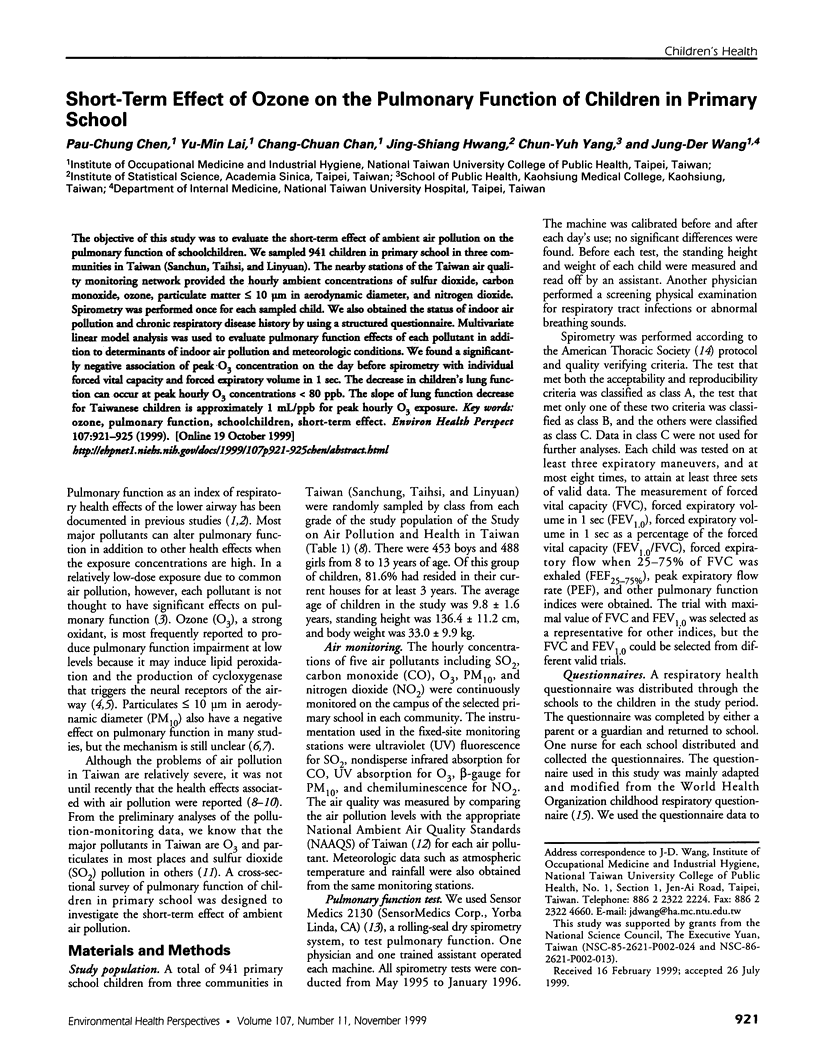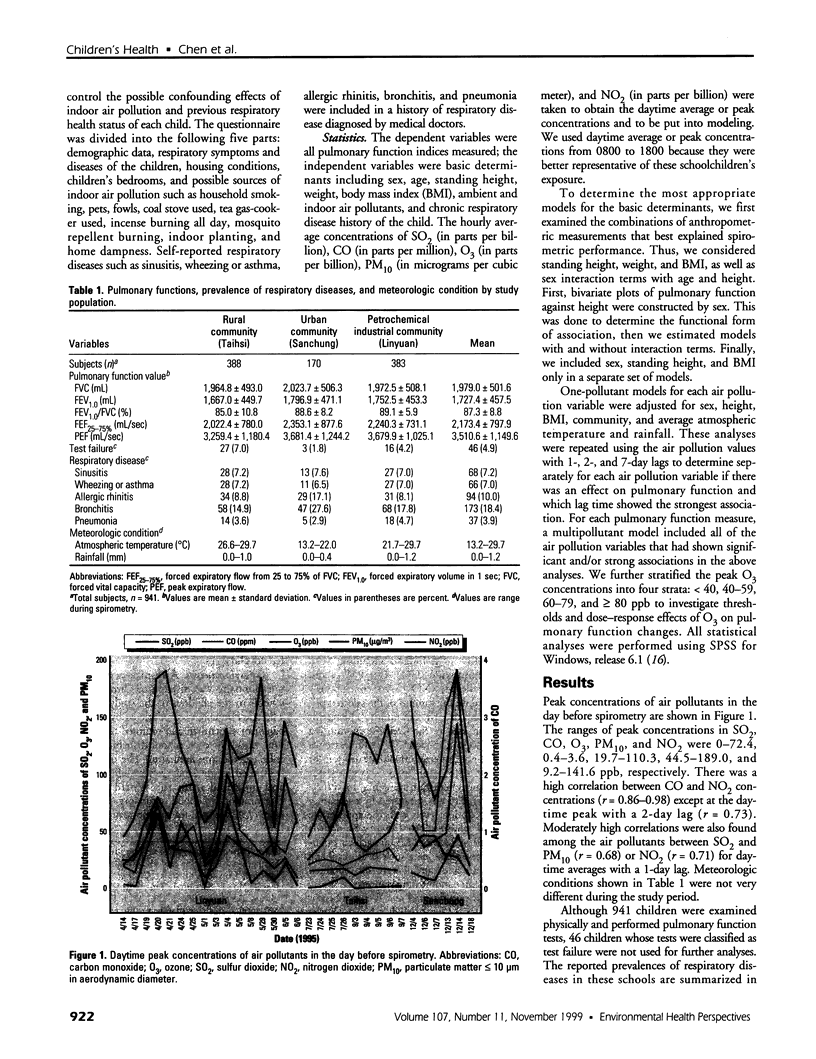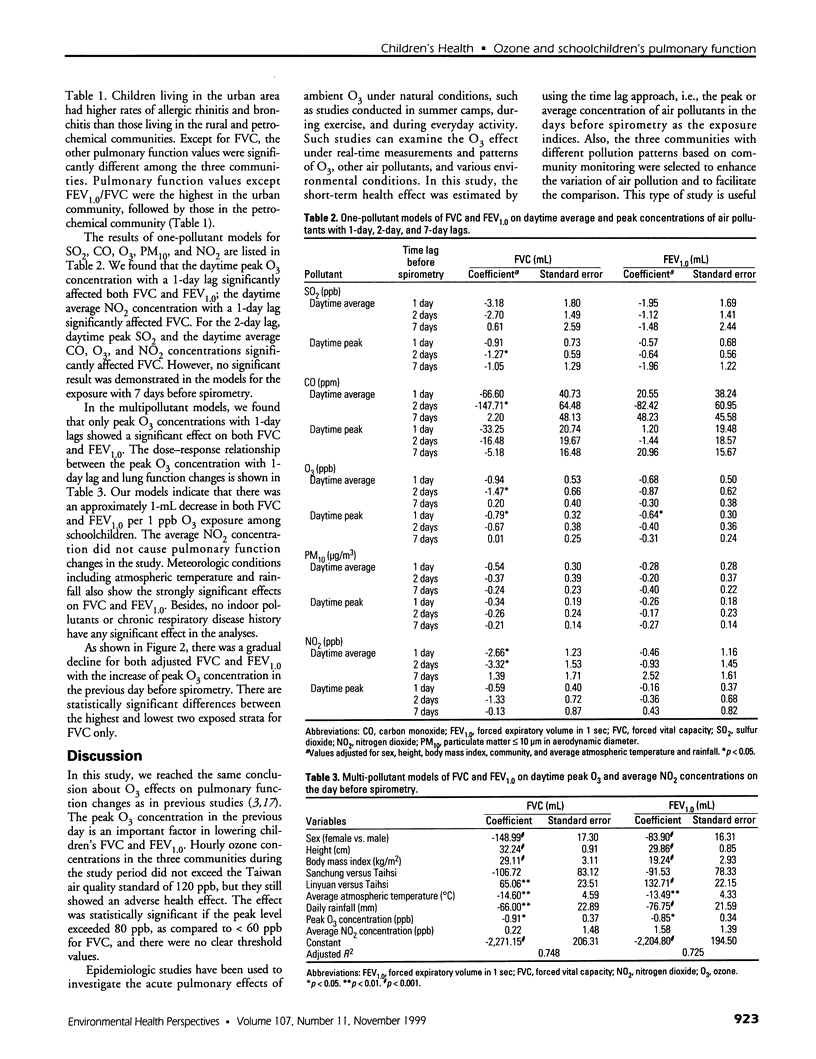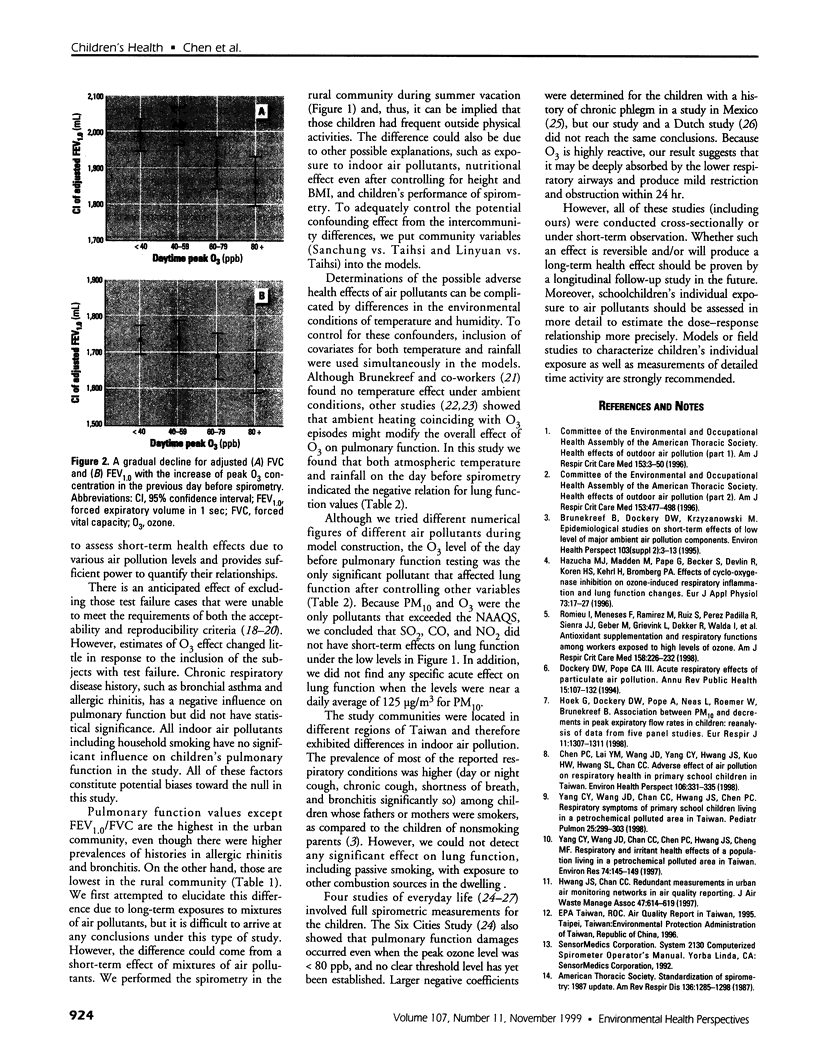Abstract
The objective of this study was to evaluate the short-term effect of ambient air pollution on the pulmonary function of schoolchildren. We sampled 941 children in primary school in three communities in Taiwan (Sanchun, Taihsi, and Linyuan). The nearby stations of the Taiwan air quality monitoring network provided the hourly ambient concentrations of sulfur dioxide, carbon monoxide, ozone, particulate matter < or = to 10 microm in aerodynamic diameter, and nitrogen dioxide. Spirometry was performed once for each sampled child. We also obtained the status of indoor air pollution and chronic respiratory disease history by using a structured questionnaire. Multivariate linear model analysis was used to evaluate pulmonary function effects of each pollutant in addition to determinants of indoor air pollution and meteorologic conditions. We found a significantly negative association of peak O(3) concentration on the day before spirometry with individual forced vital capacity and forced expiratory volume in 1 sec. The decrease in children's lung function can occur at peak hourly O(3) concentrations < 80 ppb. The slope of lung function decrease for Taiwanese children is approximately 1 mL/ppb for peak hourly O(3) exposure.
Full text
PDF




Images in this article
Selected References
These references are in PubMed. This may not be the complete list of references from this article.
- Brunekreef B., Dockery D. W., Krzyzanowski M. Epidemiologic studies on short-term effects of low levels of major ambient air pollution components. Environ Health Perspect. 1995 Mar;103 (Suppl 2):3–13. doi: 10.1289/ehp.95103s23. [DOI] [PMC free article] [PubMed] [Google Scholar]
- Brunekreef B., Hoek G., Breugelmans O., Leentvaar M. Respiratory effects of low-level photochemical air pollution in amateur cyclists. Am J Respir Crit Care Med. 1994 Oct;150(4):962–966. doi: 10.1164/ajrccm.150.4.7921470. [DOI] [PubMed] [Google Scholar]
- Castillejos M., Gold D. R., Dockery D., Tosteson T., Baum T., Speizer F. E. Effects of ambient ozone on respiratory function and symptoms in Mexico City schoolchildren. Am Rev Respir Dis. 1992 Feb;145(2 Pt 1):276–282. doi: 10.1164/ajrccm/145.2_Pt_1.276. [DOI] [PubMed] [Google Scholar]
- Chen P. C., Lai Y. M., Wang J. D., Yang C. Y., Hwang J. S., Kuo H. W., Huang S. L., Chan C. C. Adverse effect of air pollution on respiratory health of primary school children in Taiwan. Environ Health Perspect. 1998 Jun;106(6):331–335. doi: 10.1289/ehp.98106331. [DOI] [PMC free article] [PubMed] [Google Scholar]
- Cuijpers C. E., Swaen G. M., Wesseling G., Wouters E. F. Acute respiratory effects of summer smog in primary school children. Toxicol Lett. 1994 Jun;72(1-3):227–235. doi: 10.1016/0378-4274(94)90033-7. [DOI] [PubMed] [Google Scholar]
- Dockery D. W., Pope C. A., 3rd Acute respiratory effects of particulate air pollution. Annu Rev Public Health. 1994;15:107–132. doi: 10.1146/annurev.pu.15.050194.000543. [DOI] [PubMed] [Google Scholar]
- Eisen E. A., Oliver L. C., Christiani D. C., Robins J. M., Wegman D. H. Effects of spirometry standards in two occupational cohorts. Am Rev Respir Dis. 1985 Jul;132(1):120–124. doi: 10.1164/arrd.1985.132.1.120. [DOI] [PubMed] [Google Scholar]
- Eisen E. A., Robins J. M., Greaves I. A., Wegman D. H. Selection effects of repeatability criteria applied to lung spirometry. Am J Epidemiol. 1984 Nov;120(5):734–742. doi: 10.1093/oxfordjournals.aje.a113941. [DOI] [PubMed] [Google Scholar]
- Eisen E. A., Wegman D. H., Louis T. A. Effects of selection in a prospective study of forced expiratory volume in Vermont granite workers. Am Rev Respir Dis. 1983 Oct;128(4):587–591. doi: 10.1164/arrd.1983.128.4.587. [DOI] [PubMed] [Google Scholar]
- Folinsbee L. J., Horvath S. M., Raven P. B., Bedi J. F., Morton A. R., Drinkwater B. L., Bolduan N. W., Gliner J. A. Influence of exercise and heat stress on pulmonary function during ozone exposure. J Appl Physiol Respir Environ Exerc Physiol. 1977 Sep;43(3):409–413. doi: 10.1152/jappl.1977.43.3.409. [DOI] [PubMed] [Google Scholar]
- Gibbons S. I., Adams W. C. Combined effects of ozone exposure and ambient heat on exercising females. J Appl Physiol Respir Environ Exerc Physiol. 1984 Aug;57(2):450–456. doi: 10.1152/jappl.1984.57.2.450. [DOI] [PubMed] [Google Scholar]
- Hazucha M. J., Madden M., Pape G., Becker S., Devlin R., Koren H. S., Kehrl H., Bromberg P. A. Effects of cyclo-oxygenase inhibition on ozone-induced respiratory inflammation and lung function changes. Eur J Appl Physiol Occup Physiol. 1996;73(1-2):17–27. doi: 10.1007/BF00262805. [DOI] [PubMed] [Google Scholar]
- Hoek G., Dockery D. W., Pope A., Neas L., Roemer W., Brunekreef B. Association between PM10 and decrements in peak expiratory flow rates in children: reanalysis of data from five panel studies. Eur Respir J. 1998 Jun;11(6):1307–1311. doi: 10.1183/09031936.98.11061307. [DOI] [PubMed] [Google Scholar]
- Hoek G., Fischer P., Brunekreef B., Lebret E., Hofschreuder P., Mennen M. G. Acute effects of ambient ozone on pulmonary function of children in The Netherlands. Am Rev Respir Dis. 1993 Jan;147(1):111–117. doi: 10.1164/ajrccm/147.1.111. [DOI] [PubMed] [Google Scholar]
- Kinney P. L., Ware J. H., Spengler J. D., Dockery D. W., Speizer F. E., Ferris B. G., Jr Short-term pulmonary function change in association with ozone levels. Am Rev Respir Dis. 1989 Jan;139(1):56–61. doi: 10.1164/ajrccm/139.1.56. [DOI] [PubMed] [Google Scholar]
- Romieu I., Meneses F., Ramirez M., Ruiz S., Perez Padilla R., Sienra J. J., Gerber M., Grievink L., Dekker R., Walda I. Antioxidant supplementation and respiratory functions among workers exposed to high levels of ozone. Am J Respir Crit Care Med. 1998 Jul;158(1):226–232. doi: 10.1164/ajrccm.158.1.9712053. [DOI] [PubMed] [Google Scholar]
- Yang C. Y., Wang J. D., Chan C. C., Chen P. C., Huang J. S., Cheng M. F. Respiratory and irritant health effects of a population living in a petrochemical-polluted area in Taiwan. Environ Res. 1997;74(2):145–149. doi: 10.1006/enrs.1997.3762. [DOI] [PubMed] [Google Scholar]
- Yang C. Y., Wang J. D., Chan C. C., Hwang J. S., Chen P. C. Respiratory symptoms of primary school children living in a petrochemical polluted area in Taiwan. Pediatr Pulmonol. 1998 May;25(5):299–303. doi: 10.1002/(sici)1099-0496(199805)25:5<299::aid-ppul2>3.0.co;2-e. [DOI] [PubMed] [Google Scholar]




